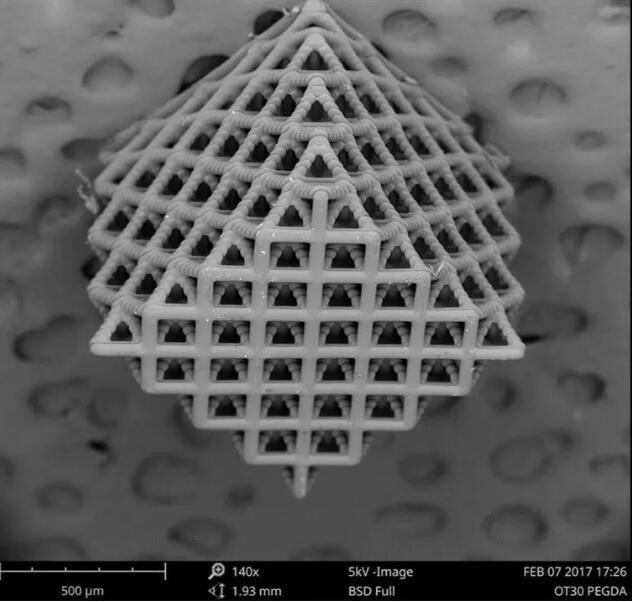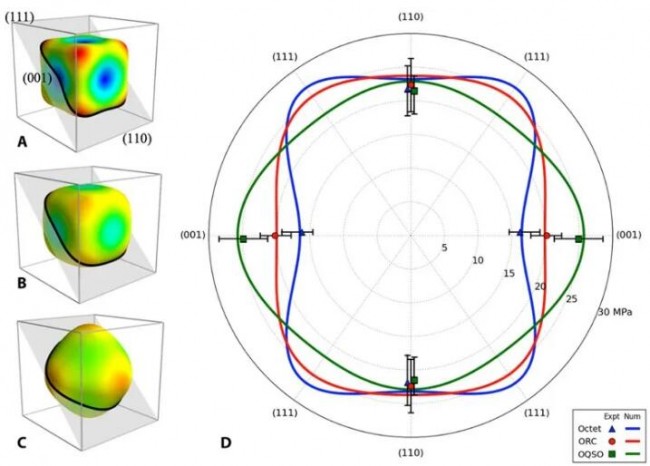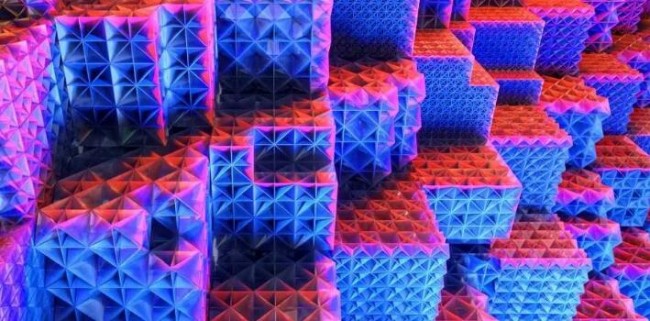Scientists at Lawrence Livermore National Laboratory (LLNL) designed a new type3D printingLattice structure, this structure combines the advantages of ultra-light structure and high stiffness, breaking the previous Maxwell design rules that needed to show such characteristics. They specially developed a design software for this purpose. Using the topology optimization software they wrote, they created two unique unit cell designs composed of micro-architecture trusses, one of which was designed to have isotropic (same and omnidirectional) material properties .
SEM observed the classic octahedral lattice and topological optimization, isotropic oblate and quasi-spherical octahedral lattice obtained by using projection microscopy and stereolithography printing technology. ©LLNL
“Powerful” depends on “small”
Materials with random microstructures, such as foam materials, typically exhibit low mechanical strength, while design grid structures with microstructures often exhibit significantly increased rigidity. These periodic structural materials have been previously used Designed through certain rules, using Maxwell’s criterion to ensure that their deformation is mainly restricted by the stretching of their prisms.
Classical design tends to be anisotropic when following this rule, and its rigidity depends on the direction of the load, but recently, isotropic design has been reported to be achieved when superimposed on complementary anisotropic lattices.
![]() Break the previous design rules
Break the previous design rules
Researchers from the Lawrence Livermore National Laboratory (LLNL) in the United States have designed a new type of 3D printed lattice structure material. This design combines the advantages of ultra-lightness and high rigidity. Although this design breaks the nature of the earlier design rules. The structure of this design additionally shows that the deformation response can be uniform when force is applied in different directions.
The LLNL research team published this result in the top issue “Science Advances” as described. Under the leadership of Seth Watts, the research team used topology optimization software to design two unique unit cell lattice designs. Its composition is a micro-structure truss, one of which is designed to have isotropic material properties (that is, the properties are consistent in all directions). After these new structures were manufactured and tested, the study found that their performance was better than the octal prismatic structure, which is a standard shape used for 3D printing lattice structures.
The relationship between the Young’s modulus and the direction of the uniaxial load state (the vector of the unit lattice)
What surprised the researchers was that the structure of the crystal lattice frame appeared to obviously violate the Maxwell criterion, which is a structurally rigid treatment method for mechanical design. The principle assumes that the structure can withstand the maximum payload. When deformed, only when stretched. In this structure, the rigidity has a linear relationship with the density-if the weight of the material structure is halved, the rigidity is only halved. On the contrary, the effectiveness of the rigidity of the structure will be reduced by a third or one eighth. This linear scale makes it possible to create ultra-light, ultra-rigid mechanical metamaterials.
According to Watts, the co-author of the paper, researchers have always believed that Maxwell’s criterion is necessary and sufficient when applying low-density, high-rigidity materials. LLNL’s research results prove that this criterion is no longer a necessary prerequisite. In other words, there are a large number of prisms with this linear scale criterion.
This work shows that this new design concept will get better material properties that were previously thought to be impossible, because this design concept violates the traditional design concept. LLNL researchers found that this work also proved that after using topology optimization technology, engineers can design new structures to overcome the performance of materials obtained using traditional design concepts.
The researchers tested samples of different densities to observe what happens when they are compressed at different angles. The experimental results overturned the classic octahedral prism design theory.
Researchers claim that the isotropic prismatic structure can be extended to3D printingMetals and ceramics, in addition to the application of biomaterials, such as3D printingBiological tissues are very important when modulated rigidity is required. Applications in this area will also be found in the aerospace field. In UAVs or fighter jets, for example, where weight reduction is required, it has a dual significance, increasing the maneuverability of the equipment and reducing the inertia of the equipment, making it have excellent performance.
The lightweight structure design can also reduce manufacturing costs, fuel consumption and reduce material waste. At the same time, it also has other advantages, such as a more optimized structure for engineering structures. LLNL’s long-term research goal is to turn to the creation and use of LLNL’s latest material database.
The LLNL laboratory is continuing to carry out their work, including the complete characterization of the physical characteristics of the lattice structure of the prepared material, under the premise of exceeding its linear elastic modulus, including heat transfer, nonlinear mechanical properties, vibration and failure conditions Characterize its physical characteristics.
A flat-plate lattice structure material that will be used in the future for ultra-light porous structure materials
(Editor in charge: admin)





0 Comments for “LLNL develops ultra-light and ultra-hard 3D printed lattice structure”